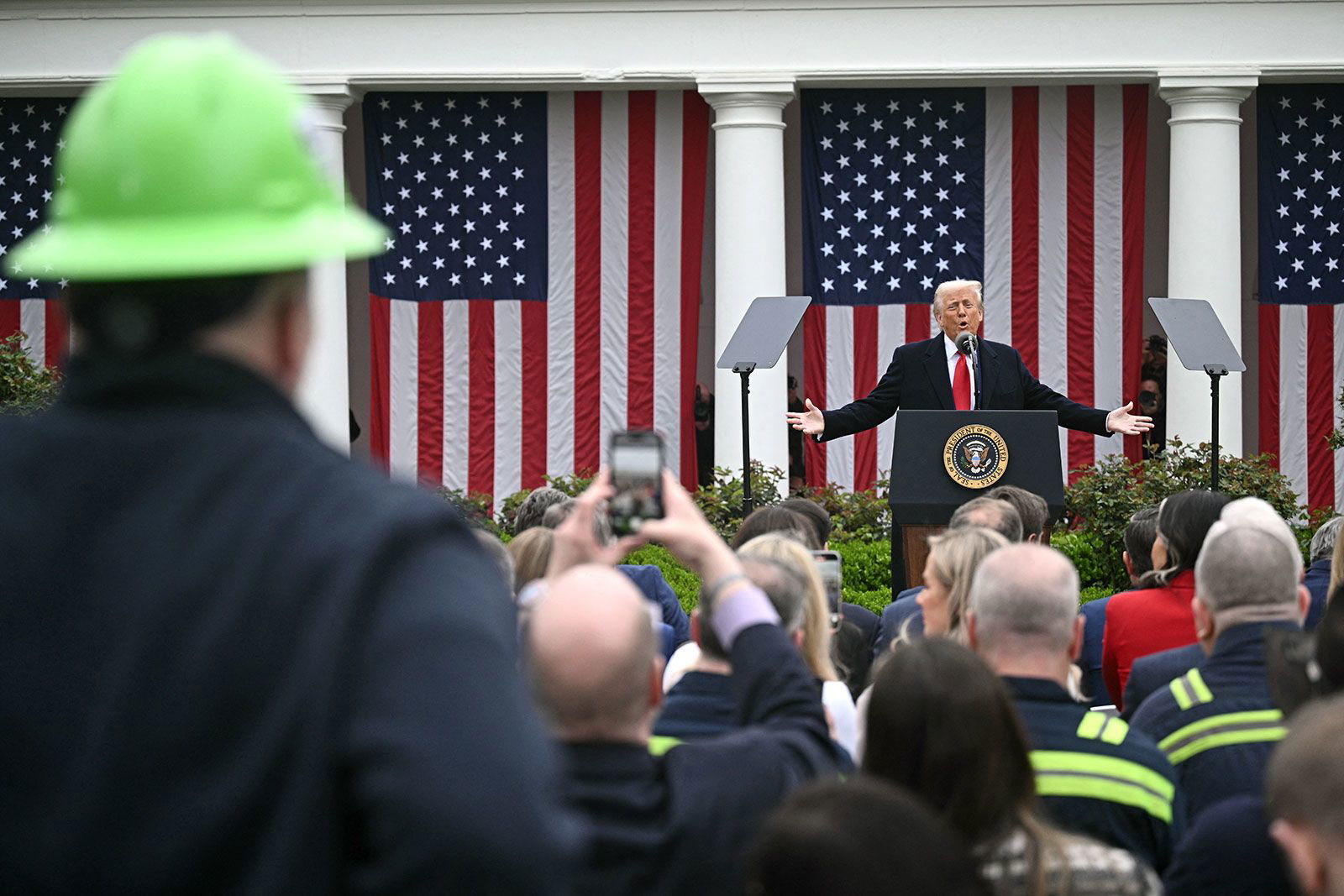Fact check: Trump’s false claims about tariffs and trade

President Trump makes remarks to attendees at the "Make America Wealthy Again" on April 2.
By Daniel Dale, CNN
(CNN) — President Donald Trump made a series of false claims about tariffs and trade – most of which he has made before – in the Wednesday speech in which he announced a sweeping set of global tariffs.
Here is a fact check of some of Trump’s remarks.
Canada’s dairy tariffs
Trump correctly noted that Canada has tariffs exceeding 250% on some US dairy products. However, he falsely claimed that merely “the first little carton of milk” exported to Canada faces a “very low price,” but “then it gets up to 275, 300%.”
In reality, Canada has guaranteed that tens of thousands of metric tons of imported US milk per year, not merely a single carton, will face zero tariffs at all; Canada conceded a certain guaranteed level of tariff-free US access to its dairy market as part of the United States-Mexico-Canada Agreement (USMCA) that Trump’s own first administration negotiated.
Trump also didn’t mention something the US dairy industry acknowledges: The US is not hitting its zero-tariff maximum level of exports to Canada in any category of dairy product, so the Canadian tariffs aren’t being applied; with regard to milk in particular, the US isn’t even at half of the tariff-free quota. (There is a vigorous US-Canada debate about why the US is so far from the maximum, with each country blaming the other. Regardless of who’s right, the tariffs aren’t hitting US milk.)
Trump has persistently omitted key facts about Canada’s dairy tariffs. You can read more here from a previous CNN fact check.
US trade deficit with Canada
Trump, claiming “we subsidize a lot of countries,” falsely said “it’s close to $200 billion a year” with Canada. Trump has repeatedly used this $200 billion figure to describe the US trade deficit with Canada in particular, which is actually far lower than $200 billion; official US statistics show the 2024 deficit with Canada in goods and services trade was $35.7 billion and $70.6 billion in goods trade alone.
Trump didn’t mention the trade deficit in particular this time, but even if he was intending to use the word “subsidize” more broadly, there is no basis for the claim.
Who pays tariffs
Trump repeated his frequent false claim that, because of the tariffs he imposed on China during his first term, the US “took in hundreds of billions of dollars” that “they paid.” In fact, US importers, not foreign exporters like China, make the tariff payments, and study after study has found that Americans bore the overwhelming majority of the cost of Trump’s first-term tariffs on China; it’s easy to find specific examples of companies that passed along the cost of the tariffs to US consumers.
Previous presidents’ tariffs on China
Trump also repeated his frequent false claim that, before his first presidency, China “never paid 10 cents to any other president” from tariffs. Aside from the fact that US importers make the tariff payments, the US was actually generating billions per year in revenue from tariffs on Chinese imports before Trump took office; in fact, the US has had tariffs on Chinese imports since 1789. Trump’s predecessor, President Barack Obama, imposed additional tariffs on Chinese goods.
US wealth
Touting the supposed benefits of tariffs, Trump claimed that “the United States was proportionately the wealthiest it has ever been” from 1789 to 1913, when tariffs made up a higher percentage of federal revenue before the passage of a 1913 law reestablishing the federal income tax.
Trump didn’t explain what he meant by “proportionately the wealthiest,” but by standard measures, the US is far wealthier today than it was in the early 20th century and prior. Per capita gross domestic product is now many times higher than it was then.
Douglas Irwin, a Dartmouth College economics professor who studies the history of US trade policy, said in February after Trump had made similar claims, that if Trump’s unclear comments are interpreted to be about per capita income, as “economists usually take this,” it is “obviously not true,” since “real per capita income and standards of living are so much higher today than the past. … It is nice to have indoor plumbing, running water, not outhouses, etc.”
Irwin noted then that it’s possible Trump had been referring to how the federal government after the Civil War “ran consistent budget surpluses and almost paid off the national debt,” since “he seems to view the government taking in more money than it is spending as making the country rich.” Irwin added, though, that “big fiscal surpluses don’t make a country rich, per se.”
Inflation under Biden and Trump
Trump falsely claimed that, during Joe Biden’s presidency, the US had “the highest” inflation “in the history of our country.” Trump could have fairly said that the year-over-year US inflation rate hit a 40-year high in June 2022, when it was 9.1%, but that was not close to the all-time record of 23.7%, set in 1920. (And the rate then plummeted. Inflation in the last full month of the Biden administration, December 2024, was 2.9%; it was 3% in January 2025, a month partly under Biden and partly under Trump.)
Trump also claimed that there was “virtually no inflation” during his first presidency. He gave himself some wiggle room with the word “virtually,” but it’s worth noting that there was inflation during his first four years in office; prices rose about 8% from the beginning of that presidency to the end. Year-over-year inflation was 1.4% in the month he left office, January 2021.
Gas prices
Trump, claiming he has brought prices “way down” since taking office again in late January, said that “gasoline is way under $3.” That is true in some parts of the country, but the national average for regular gasoline on the day he spoke was about $3.24 per gallon, according to data published by AAA – higher than on Trump’s inauguration day, when the AAA national average was about $3.12.
That’s not to say Trump is responsible for the increase; presidents have a limited impact on gas prices, and there was a larger increase over the equivalent period last year. But the national average has not fallen during this presidency to date.
This story has been updated with additional details.
The-CNN-Wire
™ & © 2025 Cable News Network, Inc., a Warner Bros. Discovery Company. All rights reserved.


